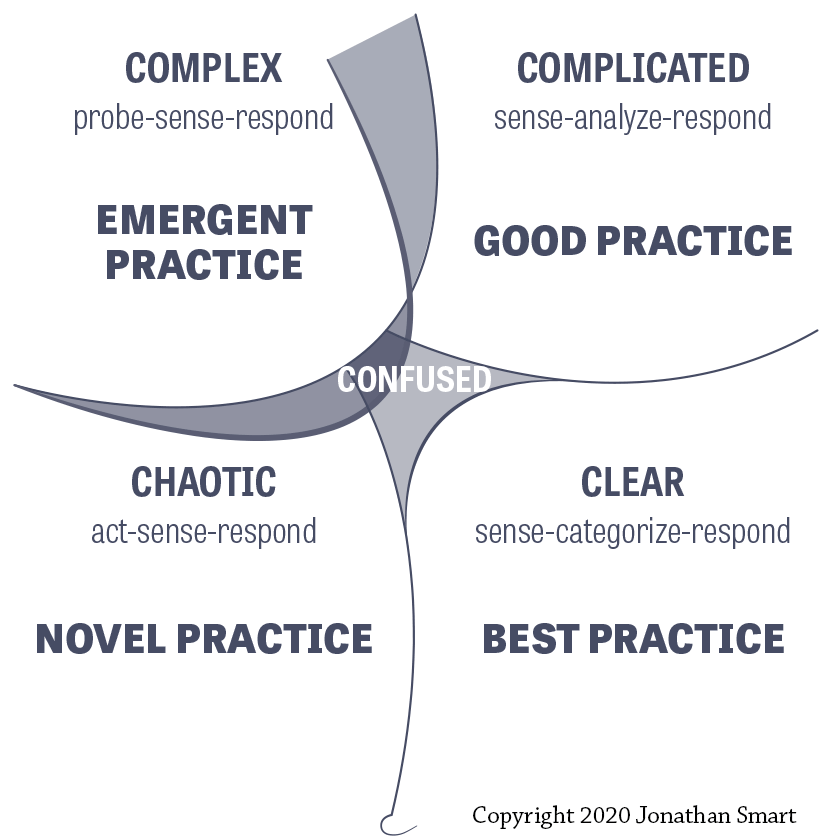I was recently asked to do some work on portfolio management structure around a set of projects. I decided to wrap some project management (PM) best practices around the effort. There was a difference of opinion on whether this needed those elements or whether it was just a “task”.

I will describe more about that situation and how it ended up, but first lets take a look at a framework that aids in talking about it. While Dave Snowden was with IBM in the 1990’s, he developed the Cynefin Framework (wikipedia) and HBR published a good article about it. One of the podcasts that I regularly listen to had Mark Madsen on to talk about “Why Agile might be wrong for your product project”. He used Snowden’s Cynefin framework. I am certainly no Dave Snowden, but I will aim to summarize…..
- Clear: These are the known knowns. There is no ambiguity about the cause and effect. A given effect is desired so it is clear what cause should be undertaken. “Tasks” definitely fall into that category: Do the dishes, sort this list, pick the fruit from the tree, etc….. As the world changes, it is possible that the cause/effect can change. One should always be on the lookout for “because that’s the way we have always done it”.
- Complicated: again, here, there is clear cause and effect relationships. But, this time one needs expertise to know them. eg. a good car mechanic can find and diagnose many different car issues in a few minutes. The cause and effect is there, most of us just cannot recognize it. While finding and relying on experts is very efficient, here too, we must make sure that experts are continuously updating their cause/effect understanding rather than resting on static laurels.
- Complex: for these types of problems the inputs may be less well understood or the cause/effect relationship of different actions may be uncertain. Most problems at a senior level in the business world fall into this category because there are so many contributing factors to any decision. Measurement and especially leading indicators with correlation to desired outcomes have become important as a part of trying to bring some order to the complexity. In this realm one has to be open to decision by probability and fast fail experimentation.
- Chaotic: This environment is pretty rare. One could argue that the early days of COVID fell into this category. The job of a leader here is to convert portions of the chaos into complexity and prioritize resources towards working on that complexity. Chaos is also emotionally difficult so a good leader provides a calming and motivating influence in order to support focus over flailing. Because these environments are so emotionally and intellectually challenging those who do successfully lead through them are often seen as heroes.
Understanding your environment and acting accordingly is not something taught effectively at most business schools. Yet, one could argue that using the wrong playbook is never going to work regardless of how good the plays are.
Back to the situation that spawned this post:
- my interpretation of the situation was that there are multiple stakeholders, they all have different goals/prioritities/skills/etc…. and therefore any system that is going to help them organize and prioritize definitely falls into the Complex category. My first action was to seek stakeholder info.
- my colleague’s interpretation of the situation was that the situation was Complicated. She felt that we should document some best practices based on limited information, present that to the stakeholders, and then adjust based on feedback.
Both approaches are supported by modern methodologies. The first is a customer development approach that seeks to understand customer/stakeholder needs and then iteratively develop to those needs. The latter is a hypothesis driven approach that seeks to develop intelligently formed hypotheses and then test how customers respond to them.
Ultimately, if my colleague and I had used this framework to understand each other, we likely could have more easily/quickly aligned.

